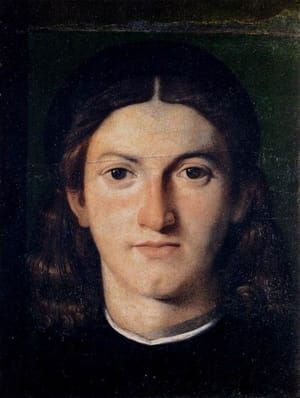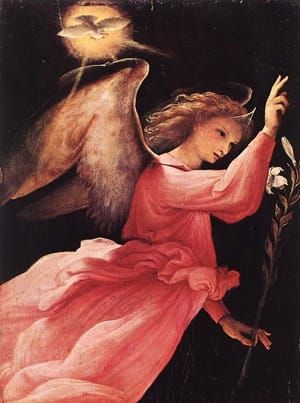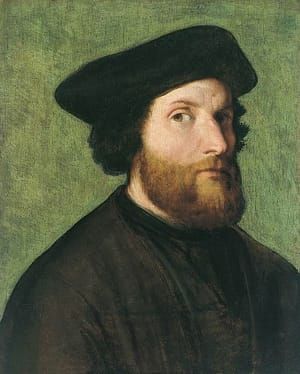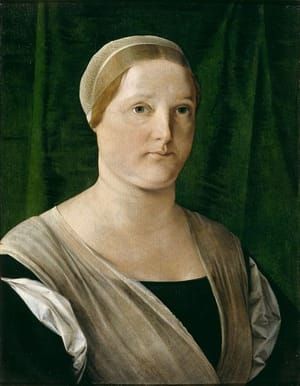
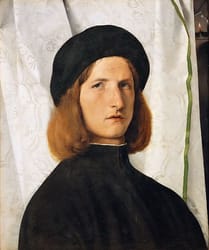
Portrait of a Young Man with a Lamp i, 1506
Lorenzo Lotto
Sometimes referred to "Young Man against a White Curtain."
Lotto's early portrait of a young man wearing a round black beret and buttoned, black coat still owes much to the traditional aesthetic of imitation. Scholars have rightly pointed to the influence of Giovanni Bellini here. The physiognomy of his powerful nose and searching grey-brown eyes, which, under the slightly knitted brow, seem to brood on the spectator, to view him almost with suspicion, is so faithful a rendering of empirical detail that we are reminded of another painter, one whose brushwork was learned from the Netherlands' masters: Antonello da Messina. What is new here is the element of disquiet that has entered the composition along with the waves and folds of the white damask curtain. A breeze appears to have blown the curtain aside, and in the darkness, through a tiny wedge-shaped crack along the right edge of the painting, we see the barely noticeable flame of an oil-lamp.
Curtains are an important iconographical feature in Lotto's work. The motif is adopted from devotional painting, where it often provided a majestically symbolic backdrop for saints or other biblical figures. Since early Christian times, the curtain had been seen as a "velum", whose function was either to veil whatever was behind it, or, by an act of "re-velatio", or pulling aside of the curtain, to reveal it. To judge from the curtain which fills most of Lotto's canvas, we may safely conclude that he intends to reveal very little indeed of the "true nature" of his sitter. What he finally does reveal is done with such reserve and discretion as to be barely insinuated. For the burning lamp is undoubtedly an emblem of some kind. It may, in fact, be an allusion to the passage in St. John: "lux in tenebris" ('And the light shineth in darkness', John 1, 5). It is interesting to note that Isabella d'Este chose to cite this light/darkness metaphor in her own "impresa" in 1525, altering the original to refer to her isolation at the Mantuan court: "sufficit unum (lumen) in tenebris" (a single light suffices in the darkness). Perhaps Lotto intended to convey a similar message through his portrait of this young man. (http://hoocher.com/Lorenzo_Lotto/Lorenzo_Lotto.htm)
The Portrait of a Young Man with a Lamp is a painting by the Italian High Renaissance painter Lorenzo Lotto, dating to c. 1506. It is housed in the Kunsthistorisches Museum of Vienna, Austria.
The work is generally ascribed to Lotto's stay in Treviso. It was acquired by the Viennese museum in 1816.
The picture portrays the bust a young man from three-quarter, looking at the seer. It shows an extreme attention to details, such as the slight epidermic imperfections, the elongated nose, the soft hair. The use of light and the composition are similar to other early work by Lotto, such as the Portrait of Bishop Bernardo de' Rossi (1505). The face is framed by the dark clothes and hat, painted over a white brocade drapery with a green border.
On the right, an opening to a darker background shows a lightened lamp, a symbol which could allude to the man's personality or deeds, and which has been variously interpreted (from a reference to an evangelic episode to an allegory of the human life's shortness, due the dimness of the flame).
The subject has been identified as Broccardo Malchiostro, the young chancellor of the bishop of Treviso, Bernardo de' Rossi, who both risked their lives in a plot in 1503. The decoration of the drapery would thus be a charades: it is a brocade with carduus, whence "Brocade + carduus = Brocardus". Such allusions are contained in several Lotto works, such as the Portrait of Lucina Brembati, painted during his maturity. (https://en.wikipedia.org/wiki/Portrait_of_a_Young_Man_with_a_Lamp)
Uploaded on Oct 6, 2016 by Suzan Hamer
Lorenzo Lotto
artistArthur
Wait what?
